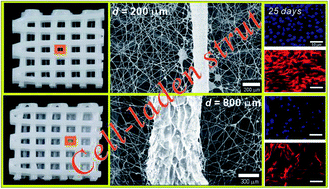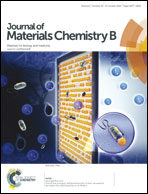Optimal size of cell-laden hydrogel cylindrical struts for enhancing the cellular activities and their application to hybrid scaffolds
Abstract
Biomedical scaffolds must be mechanically stable and highly porous three-dimensional (3D) structures to allow efficient cell-to-cell and cell-to-substrate interactions, induce blood vessel formation, and transfer oxygen, nutrients, and metabolic waste. A 3D cell-laden hybrid scaffold consisting of a combination of structural synthetic polymers and a cell-laden hydrogel is an outstanding biomedical scaffold due to its controllable mechanical properties, multiple cell loading, and homogeneous cell-distribution within the scaffold. But although this hybrid scaffold is better than conventional scaffolds, some issues must still be overcome. One is the controllability of cell release from the cell-embedded hydrogel. Here, we propose a method to solve this problem using a geometric cell-laden hydrogel. Various cylindrical cell-laden strut sizes (diameter: 100, 200, 400, and 800 μm) using osteoblast-like-cells (MG63) were investigated A diameter of 200 μm was the most attractive to efficiently induce cell release and proliferation based on cell viability and fluorescence analyses. In addition, cell-laden alginate struts (200 and 800 μm) were used to fabricate poly(ε-caprolactone) hybrid scaffolds; the hybrid scaffolds were interlayered with a cell-laden hydrogel (200 μm), demonstrating significantly high osteogenic expression compared to scaffolds laden with 800 μm struts.


 Please wait while we load your content...
Please wait while we load your content...